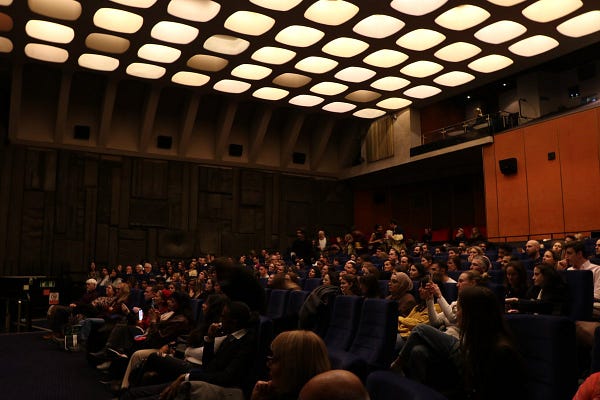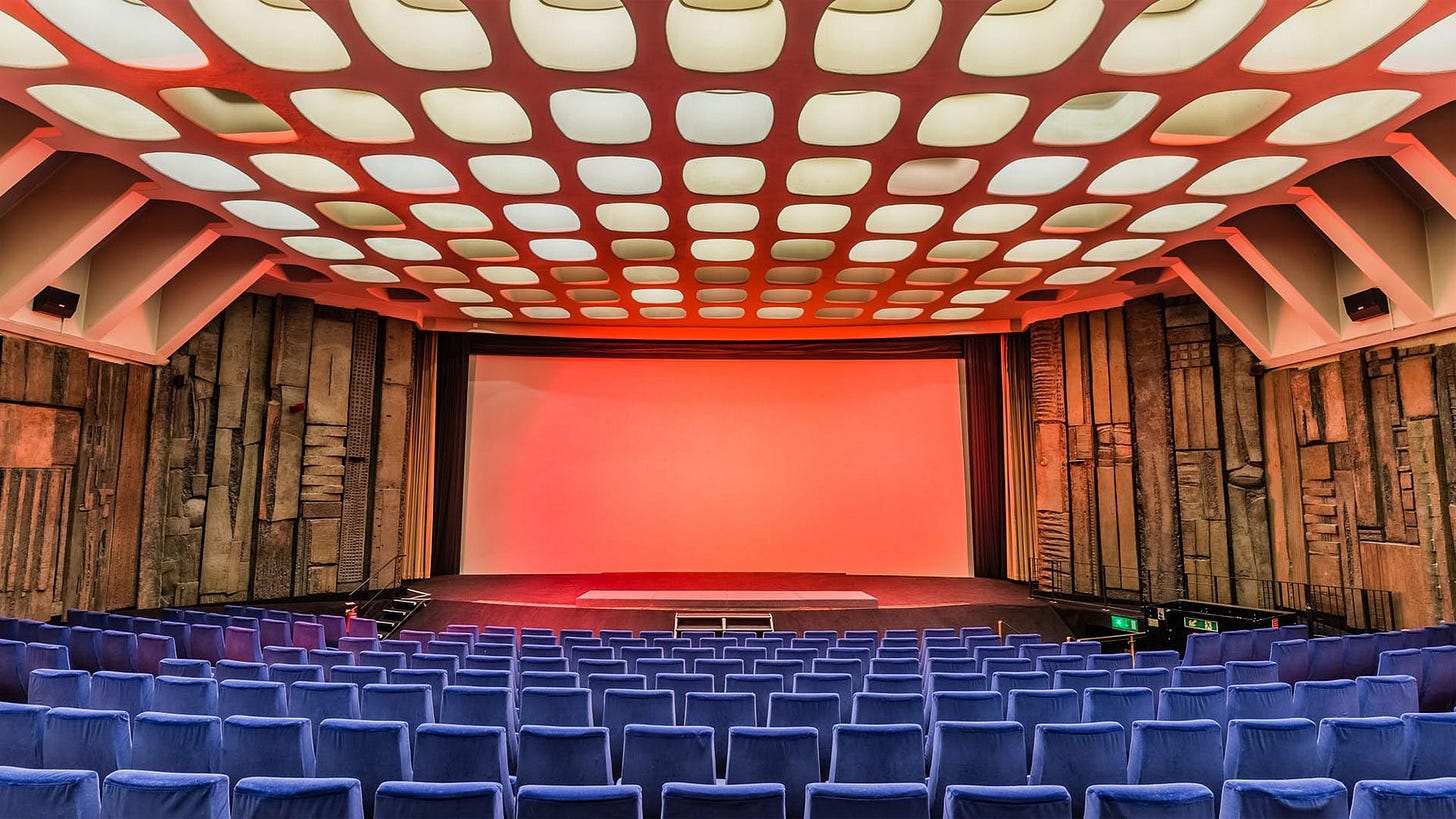The curse of the Curzon... continued
Part two of our look at what the closure of the Curzon Mayfair means for London
In Monday’s issue we started to look at the reasons behind the closure of the Curzon Mayfair cinema, and why the framing of that as ‘good news’ by certain parts of London’s press felt like laziness at best and misdirection at worst.
What we know so far is that, in 2016, a development company called 38 Curzon Ltd tried to force the cinema out by complaining about the noise made by the screenings. That attempt was foiled by 27,000 signatures on a petition and the mayor stepping in. But then, as the Curzon’s 90-year lease neared its end and despite the cinema becoming an Asset of Community Value, the landlords terminated the lease by making themselves ‘owner operators’ of the building. To soften that blow they announced a £15m redevelopment of the building that would bring the “cinema back to life… reinstating it to its former glory and reinventing the art of cinema-going.”
Last week, Time Out and the Metro ran identikit articles parroting the developer’s press release and quoting 38 Curzon boss, Dan Zaum‘s promises that whatever comes next will be “a vibrant venue serving the wider community,” which “will always have film at its heart”.
On Monday we tracked 38 Curzon Ltd back to Vevil International, the same group that tried to evict Corbin & King from the Wolseley in 2021, and which has been buying up and redeveloping big chunks of premium real estate for the past few years, including The Ned and Koko.
Today we’re looking at the wider picture, to see what the closure of one cinema tells us about the balance of power in London’s property markets. But first we have to find out who is behind Vevil International. Surely it’s not another of those mysterious Russian oligarchs…
The Russia Houses
The owner of Vevil International is a Russian-born Belgian oligarch called Vladimir Zemtsov.
This is where we’d usually put a photo of Vladmir, but we can’t do that, because there aren’t any. Vlad’s profile is lower than a mouse’s belly on a Tube track.
All we know about him is that he’s 63 years old, he’s resident in England and he’s very, very rich. Google has almost nothing on him. In fact, the only real information we have on Vladimir comes from that leak of Sony emails that happened back in 2014.
Contained in the leak was an email from the President of Sony Pictures Entertainment International to the company’s CEO, concerning “a new friend in London who would be interested in talking with you about potentially investing in Sony films.”
That friend is Vladimir Zemtsov, who was then fresh from “long discussions with Harvey Weinstein about investing in his slate,” and who is described as “a big property magnate in London (owns about 40 significant buildings), but maintains a fairly low profile.”
The email continues:
“By the way, I was at Len Blavatnik’s last night and he told me he had come close to doing something with you. Vladimir is friends with Len... If you are interested, he will come to LA to meet with you when I am next there. Let me know...”
Sir Len Blavatnik is, of course the Ukrainian-born billionaire who is now England’s richest man and the philanthropist behind many of London’s biggest cultural institutions (although that philanthropic nature came under quite a bit of scrutiny once Russia invaded Ukraine, thanks to Len’s links to sanctioned Russian oligarchs).
Apparently, there was a documentary made in 2019 about the “Russian-born businessman with a Belgian passport living in the UK,” which investigated why Zemtsov emigrated to London and “the source and amount of his wealth”. But, if it was ever released, that documentary has never made it on to the internet (maybe someone clocked how viciously litigious kleptocrats and oligarchs can be).
Why does any of this matter?
Shouldn’t we just do what Time Out did: take the press release at face value and be happy that a ninety-year-old cinema is getting £15 million spent on it?
No. And that’s reason number one for writing these issues: It’s another argument against the likes of Metro and Time Out being trustful publications. Okay, so nobody ever really trusted the Metro to deliver quality journalism about London; but in 2015, Time Out was imploring its readers to ‘Save our cinemas’ (admittedly as part of a weird ‘16 ways London is under threat’ listicle). Back then the magazine specifically called out “The mighty Curzon Soho, where generations of Londoners have discovered that not all films are in English”.
What a difference eight years makes.
The second reason is because (to quote Westminster Council) the Curzon is “an important community asset for the area”. In other words, it’s a local arthouse cinema, and we don’t have many of those left. Less than two weeks ago we found out that the Kino cinema in Bermondsey was closing thanks to a “landlord rent hike”. The Kino was a lovely cinema that we have a bit of affection for because we used to hold events there a few years ago (when it was called the Shortwave Cinema). At that time, we would charge £10 a ticket to cover the cost of renting the 50-seat screen. There is absolutely no way we could do that in a central London cinema now.
This week it was reported that Vue might be buying up the almost-bankrupt Cineworld. If that happens then it will make the cinema offering across London even more homogenous than it already is, and will put a big question mark over the future of the Cineworld-owned Picturehouse chain (of which there are fourteen in London right now).
As well as being a beautiful, Grade II listed building that’s completely accessible to anyone that can afford a ticket, Curzon Mayfair shows films that wouldn’t necessarily get a release elsewhere. Last week the cinema hosted a sold-out UK premiere of You Resemble Me, a film about Europe’s “first female suicide bomber” directed by Dina Amer and exec produced by Spike Lee, Spike Jonze, Riz Ahmed and Alma Har’el.





The Curzon was pretty much the only cinema in London showing that film. Will that happen once Vevil have spent £15m on “reinventing the art of cinema-going”?
When Vevil redeveloped Koko in Camden, much of the money went towards creating its members’ club, House of KOKO. Now, four floors of that venue (including three restaurants, a roof terrace, recording studio, piano room, library, two bars and “hidden vinyl rooms”) are only accessible to people who are able to pay up (there’s a discount for those under 25, but it’s still at least £500 just to walk through the door).
When the 38 Curzon developers talk about “plans for a new bar and a dine-in restaurant” and being able to have “a full evening out,” in the new ‘Mayfair Cinema’ you have to wonder how much of that experience will be available to the kind of person who goes to the Curzon today.
Lights out for the kleptocracy
“We must go after the oligarchs,” declared Boris Johnson a few weeks after Russia invaded Ukraine.
Our law enforcement agencies must be given “unprecedented powers to peel back the façade of dirty Russian money in London,” said the then Prime Minister, stating his intent to pile economic pressure on Putin.
A few ineffectual sanctions were implemented, followed by the announcement of the Register of Overseas Entities, which was designed to crack down on those “corrupt elites” using UK property to launder illegal wealth by removing their “secretive chains of shell companies”.
That did not work. Not at all.
A week ago, the BBC reported that half of the firms required to declare who’s behind them haven’t done so yet, and even some of those which do appear on the public register have obfuscated their ownership by putting their companies in a trust structure.
We are not saying that Vladimir Zemtsov is a member of the “corrupt elite”. What we are saying is that any companies that secretively inject obscene amounts of wealth into London, only serve to widen already existing divisions and inequalities and to dilute and disenfranchise the kinds of communities that makes London thrive, both economically and culturally.
When the biggest signs of this were empty luxury apartments and vacant mansions it was a little harder to wrap your head around the scale of the problem. But when ‘prime central’ rental prices shot up last year, that inevitably trickled down to “people on modest incomes” and, all of a sudden, the effects of the super-rich became a little more tangible.
Now it’s right in front of us. Now we’re seeing “important community assets” being removed from our streets as if they were plastic Monopoly pieces. So now is the time for protest and outcry, not press releases and blind optimism.
You can sign the petition (another one) to save the Curzon here. It’s jumped by a few thousand since Monday and is around the 16,000-signature mark as we write this.
If you want to read about more of this stuff, there’s a few related issues from our archive below. Also, this Private Eye special report that attempts to “untangle the great offshore corporate web” is a few years old, but definitely worth a read.




